Inside Blaser Swisslube
 Let me be perfectly honest with you; in the many years I have been covering this industry, I've never been a big fan of Blaser Swisslube. Like most people, I didn't like the "good bacteria" sales pitch we heard back in the 90's. It was a misguided pitch that would be exaggerated into folklore. That's long gone, and I never had anything against them, I was just never a big fan. In recent years I have come to like some of their people that I would meet at trade shows, but that's as close as I ever came to "liking" the company. We have always acknowledged that they had a successful product line with die-hard fans for decades. I viewed them as sort of the "Grateful Dead" of the metalworking industry. I recently had an opportunity to actually see the inside of their operation, and to really see everything. This trip was going to change my view - completely.
Let me be perfectly honest with you; in the many years I have been covering this industry, I've never been a big fan of Blaser Swisslube. Like most people, I didn't like the "good bacteria" sales pitch we heard back in the 90's. It was a misguided pitch that would be exaggerated into folklore. That's long gone, and I never had anything against them, I was just never a big fan. In recent years I have come to like some of their people that I would meet at trade shows, but that's as close as I ever came to "liking" the company. We have always acknowledged that they had a successful product line with die-hard fans for decades. I viewed them as sort of the "Grateful Dead" of the metalworking industry. I recently had an opportunity to actually see the inside of their operation, and to really see everything. This trip was going to change my view - completely.
METALWORKING FLUID MAGAZINE visited the Hasle-Rüegsau Headquarters of Blaser Swisslube, Switzerland, to attend the International Machining Technology Summit of the Aerospace Industry. In attendance were titanium experts, engineers and scientists from the global aerospace industry. Titanium has replaced Aluminum as the material of choice in the aircraft industry. Titanium is very difficult to machine, and the increased numbers of superalloys makes it even more difficult. Since Titanium reacts with water, special coolants are required.
DAY 1
Travel woes aside, Day 1 of this event was supposed to be mostly fun, and it sounds like it was for anybody that got there earlier than I did. I spent the morning trying to see if the airline had found the cell phone I left somewhere near my seat. The hazards of carrying two phones. I got help from the cute girl at the hotel desk and the good news arrived when she burst out laughing "Oh my! Is it an old flip phone?" Nothing I could do but admit that. "Then they found it" she giggled. Lucky thing we called. It was minutes away from being donated to the Swiss Museum of Ancient Communications where it would be on display between the alphorn and the yodeling mannequin.
When the having-fun people returned for dinner, I joined in. This proved to be a fantastic opportunity for experienced industry experts to swap war stories and take notes. I heard some of the most interesting and innovate discussions I have heard in years, all held in a comfortable and enabling environment provided by Blaser. Clearly, a lot of technology was being shared, and that was the whole idea. There was also an extended and lively debate over the Green "Fear Factor" soup that was served. Little comfort was found in the local's inability to provide a translation for its contents. This provided me the opportunity to demonstrate my manliness by eating the entire bowl. Everyone looking at the soup is keenly aware that our personal remedies for foul play are thousands of miles away. If anything goes wrong, I will be in a ugly struggle with nature that could last through the night. I could feel their admiration. Assuming I survived the soup, I will see if I can stay awake tomorrow during the presentations and report later in the day. Switzerland is some kind of beautiful this time of year, and the hospitality has been first class. Hopefully, I get a good look at the lab.
DAY 2
This was "No Fun Day" for sure, with the last speaker finishing after about 6:30 PM. I was having caffeine withdrawals. I was so tired now that I had to take a knee to tie my shoe to keep from falling over. The presenters were surprisingly good. I was amazed at how open they were in their sharing of projections and analysis of the aerospace industry, and those projections are staggering. Here's a couple of teasers: Air travel doubles every 15 years. Between 2010 and 2020, Titanium usage will triple. By about 2030, the number of planes flying around will be double what it is now. How certain are we? Airbus is making over 50 planes a month and they have an 8 year backlog of work. Boeing is similar. Airbus seems to be catching up, but the years-old biopoly is over. New manufacturers of jets are coming to Japan, China, Russia, and Brazil. Developing nations will soon have disposable income sufficient to afford recreational travel. The phenomena is the advent of the Mass Transit Era of aerospace. The worldwide automotive industry usage of Titanium is insignificant in comparison to aerospace. They have to mine enough Titanium for 9 aircraft to build 1. One-third of all Titanium is recycled. In Titanium manufacturing, high pressure coolant is the name of the game.
According to Marc Blaser, MWF accounts for only .5% of the manufacturing cost of Titanium components, but as compared to the other 95%, it is in best position to account for a greater cost savings than any other component, as it touches so many others. These include tooling (5%), human resources, (50%) and others factors. He was the first of many to discuss the explosion in fuel and manufacturing costs, and the greater than ever need to control production costs. - That is the reason this MWF Company was hosting the conference. I kept waiting for the Blaser sales pitch and it hasn't come yet. Smart move. This audience includes customers and non-customers alike. In the end, Blaser is letting the conference and their facility speak for itself. So far, that's speaking volumes. The competitve respect between speakers for Boeing and Airbus was amusing for everyone else, and their respective speakers were dynamite.
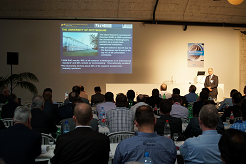
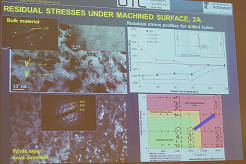
The speakers here are certainly experts on manufacturing Titanium, no question about it. But my mission here was to look inside Blaser Swisslube. Today, I finally got that tour, and I was given interview access to anyone I wanted to speak with. Blaser is making it very clear that they have nothing to hide. To the contrary, they want the world to see them as they are. Now I know why. They are forthcoming in a way that only a family owned facility can be, but this is no Mom and Pop shop. This place is very impressive. I am filming, interviewing, and photographing anything I want, and the more I see, the more I like it. The hospitality has been special, but it will take more than a few goods meals to make MWF Magazine to give up fair reporting and its smart-ass ways. The interviews are fair and tough enough.
THE TOUR
This was what I came to see. You can't fake a lab. Blaser has a beautiful working lab, the Technology Center, where products leave the beaker and meet the tool. A few years ago, Blaser made a commitment to extend it's understanding of the end use interactions of metalworking fluids in a variety of machine applications. The Technology Center and the employment of machine tool experts was the answer. Here, Blaser partners with tool manufacturers, customers, and universities to further their understanding of the performance of metalworking fluid products.


Special machines were designed to strictly control the MWF on certain operations to eliminate variables. Machined parts are inspected and compared for all aspects of quality.
But Blaser has several other labs located on this 10 building complex. We toured the Product Development Lab, where new products are created and bench tested before hitting the Technology Center and the field. The Customer Service Lab handles thousands of specimens from customers all over the world. Testing here is problem solving oriented, as the shop samples are accompanied by field reports and face a battery of test designed to troubleshoot the sample.
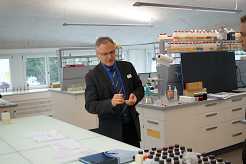
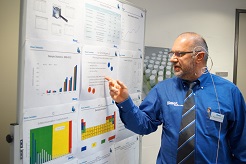
Customer Service Department Head Markus Kuhni and Dr. Raymund Weber (Product Development) were in full command of their lab operations.
There was another lab dedicated to biological testing. This place was totally Sci-fi. Seriously. I was on the look-out for a hunch-backed guy with a dragging foot. If he was there, they had him locked away for the tour. There were boiling and stirring slurries everywhere. One section looked like it should have been under armed guard in case the horrible black blobs in the several giant beakers started to climb out. I don't know what it was, but it damned sure wasn't the "good" bacteria
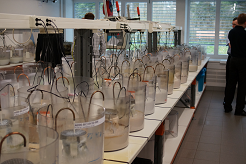
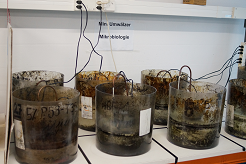
A large room filled with rows and rows of large beakers of strange things were being grown in the Micro lab. These were the scariest.
But the only true moment of terror for most of us came when somebody pointed out a bubbling solution that looked exactly like the green soup from our first dinner.
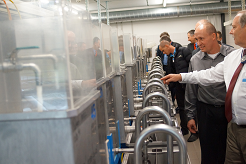
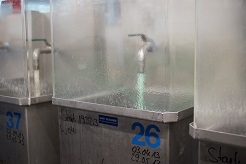
In another room, rows of tanks were continuously circulating experimental fluids. This one looked disturbingly familiar.
I escaped the lab uninfected and wondered off on my own for a while. I talked to several people that were not our assigned guides. The thing that made the biggest impression on me of the entire three days at Blaser, was how much everyone genuinely enjoys working there. I gave everyone an opportunity to say whatever they wanted. They were not concerned about being quoted, they were just talking. This family owned business clearly benefits from a strategy of providing it's employees with an open and enjoyable atmosphere to work in.
DAY 3
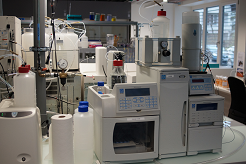
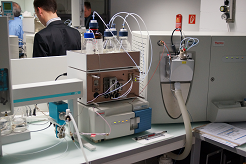
The investment in research and technology was literally everywhere, and it was all being put to use.
Conference planners take note: NEVER start the last day of the conference earlier than the previous day. There will be casualties. Fortunately, we only lost a couple of our favorite attendees who, in sheer dedication to their careers as Health and Safety Managers, had volunteered to establish the LD50 (lethal dose of 50% of the population) threshold of experimental cocktail formulations. That will make you a late arrival to DAY 3, if you're lucky. In truth, this WAS a serious and dedicated bunch, and every day of this conference was worth attending. Day 3 did not disappoint. There was rumor that if weather permitted we might get to go for a balloon ride. I briefly imaged the excitement of rising above the beautiful countryside, when my dream was interrupted by the thought of how easy it would be to get rid of the METALWORKING FLUID MAGAZINE reporter (me) from such an altitude. They would try to look sad and say "He was leaning out to take a picture." But Mother Nature was there to protect me, as the clouds prevented anyone from going up, or down.
My favorite Day 3 speaker was Alexander Kramer, whose presentation "Innovative Lubricant Strategies for Machining of Turbine Materials" was excellent. The best part was that the research didn't just answer questions, it raised several new ones. His topics included dry machining, Liquid Nitrogen and CO2 machining comparisons. The Netshape and Additive Manufacturing at the MTC presentation by Dr. Clive Hickman was an interesting look at one future of manufacturing. But to be fair, every one of the selected speakers was very good. Blaser finally put a speaker up near the close of the day. A nice guy and decent speaker, his challange was three-fold. First, all of the other speakers were so damn good that they were just hard to follow, and it was now late in the conference day. Secondly, with all of the lab data we had seen being generated in all of these Blaser labs, we didn't get to see it in this presentation. Lastly, the poor guy was heckled over a non-scientific entrained air test procedure by the asshole from Metalworking Fluid Magazine.
I had one more mission for this visit - I need to get the final word on the old "good bacteria v. bad bacteria theme" of several years ago, and to compare that with the reality of the very popular and successful Biological Concept products of Blaser. Time was running out. I raised the issue with Dr. Raymund Weber while on the tour. He suggested I visit the another one of the labs that was not on the official tour. He walked me there himself, and introduced me to the unassuming Dr. Peter Kuenzi as the guy in the Microbiology lab that really knew his stuff. I approached him and asked him for an interview and advised him that I had some tough questions about the Biological Concept Products. He agreed without even blinking. He then showed me three additional lab rooms that had restricted access, including a DNA lab. I asked the toughest questions I had, and he answered them like it was a second grade spelling bee. This was great stuff. I video-recorded this interview and I encourage you to watch it.
So I have several interviews that we need to edit for time and will post as soon as possible, and more text to add to this way- long report. But not tonight....
MORE TO COME...
The primary observation that should be learned from all of this:
YOU NEED TO VISIT YOUR MWF SUPPLIER. When something goes terribly wrong - and someday it will - a well-recognized logo or a funny salesman won't save your ass. We are asking the tough questions that you should be asking. Don't know what to ask? Watch the videos we post and ask the same questions. Use our interviews and evaluation as a metric. We're just a bunch of idiots. I'm sure you can do better. If your supplier doesn't appear as dedicated and capable as Blaser Swisslube, then keep shopping. Blaser isn't perfect, but they are very, very good. They are also sincerely committed to customer service and improving their products. If you are not getting the service from Blaser Swisslube that you expected, I can tell you now that Marc Blaser wants to fix that.


